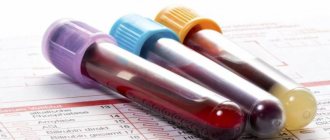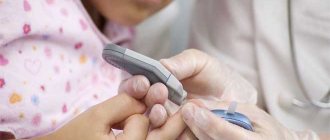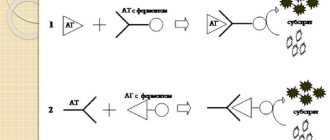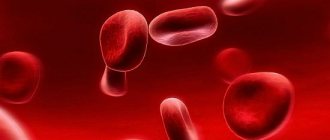In what cases should you take a stool test for stercobilin?
Most often, diagnostics are prescribed when there is a malfunction of the gastrointestinal tract. The need to analyze the reaction of feces to stercobilin is determined by the doctor after a general examination of the patient and collection of anamnesis.
The main indications for stool analysis for stercobilin:
- haemorrhoids;
- dysentery;
- pancreatitis;
- cirrhosis of the liver;
- tumors, polyps in the colon;
- cholera, salmonellosis;
- helminthic infestations;
- stomach ulcer, duodenal ulcer;
- anemia and other blood diseases.
A stool coprogram is done for complaints of abdominal pain, flatulence, heartburn, and blood discharge in the stool. If signs of poisoning are observed, a test for stercobilin in feces will help identify the pathogen and prescribe effective treatment. For children, a test for stercobilin in feces is done for allergies, suspected parasite infection, and pathologies of the small intestine and rectum.
Indications for use
A general stool test is prescribed by the doctor after the patient’s visit. Among the main indications are:
- Anal fissures and hemorrhoids.
- Ulcer of the duodenum and stomach.
- Chronic constipation and pancreatitis.
- Crohn's disease and diverticula.
- Liver cirrhosis and colitis.
- Colon polyps and malignant tumors.
- Irritable bowel syndrome and malignant neoplasms.
- Helminthic lesions and amoebic dysentery.
- Intestinal infectious diseases (salmonellosis, cholera, etc.).
- Anemia and other blood diseases.
It is mandatory to do a coprogram if the patient has symptoms such as abdominal pain, flatulence, and cramps. It is necessary to get checked if you have heartburn and problems with bowel movements.
Diagnosis is mandatory for patients who experience bleeding with stool and other symptoms that indicate that there are disturbances in the functioning of the digestive tract.
The doctor may order a general stool test to detect helminthiasis, infection or poisoning. This study allows us to identify the causative agent of the disease and prescribe effective therapy.
Among urgent cases, intoxication of the body should be highlighted in order to have time to isolate the patient from society in case of infectious diseases.
In young children, a coprogram is performed if there is a suspicion of abnormalities in the rectum or small intestine, allergic reactions and suspected parasitic diseases.
Stool analysis does not make it possible to identify pathology, but it determines disorders occurring in the body and allows the doctor to prescribe additional diagnostics.
What does the presence of stercobilin in feces mean?
A positive reaction to stercobilin is not a deviation ; on the contrary, it is good. From the age of six months, this means that the child’s digestive system is developing normally.
The main research method is the use of mercury dichloride. Upon contact with it, the feces change color intensity. The green color of the stool indicates that the pigment is absent, pink indicates the presence. The second method, using the active substance paradimethylaminobenzaldehyde, involves monitoring the intensity of the color of the material in shades of red.
Deviations of the fecal reaction to stercobilin from normal values
Stercobilin in feces is an indicator of general health and digestive function. The amount of pigment, depending on the development of a particular pathology, may increase or decrease.
The causes of increased stercobilin in feces are various diseases, anomalies, and inflammatory processes:
- hemolytic anemia;
- liver disease, increased bile production;
- overactive spleen;
- poisoning with medications, poisons;
- accelerating the process of red blood cell breakdown.
The absence of a normal amount of stercobilin in the feces often indicates a narrowing of the bile duct due to a tumor or stones, dysbacteriosis, hepatitis, acute pancreatitis, cholelithiasis, and enlarged lymph nodes.
If the absence of the stercobilin pigment is diagnosed, the color of the feces becomes almost white, and the skin takes on a yellow-green color.
Norms in children under 1 year of age
If a child is fed breast milk, then the color of feces should normally be yellow or greenish, if on artificial milk it should be gray or green.
When black color appears, pathologies such as bleeding in the intestinal or stomach area may be present. Dark brown color of stool indicates overeating, constipation or dysbiosis.
If the color is whitish or very light, the doctor may make a diagnosis such as rotavirus infection.
The amount of feces in children also matters:
- The norm is up to 1 month (20 g per day), from 1 month. up to 1 year (50 g per day).
- Exceeding normal levels - diarrhea, hepatitis or Crohn's disease.
- If it decreases, it causes colitis.
The smell should be sour. Even putrid ones are considered normal. If there is a foul odor, we are talking about constipation or dysbacteriosis. The consistency of feces in children should be viscous and unformed.
When breastfeeding or formula feeding, feces come out in a mushy form. If the stool is hard or contains lumps, then this indicates static constipation, low fluid intake or insufficient intestinal motility.
What is stercobilin? Basic Concepts
Analysis of stool is called a coprogram. She examines the microflora, appearance, and composition of the material. In addition, a general stool examination evaluates the presence of enzymes, blood clots, bile, digestive juices, bacteria, and stercobilin in the stool. A chemical method is necessary to assess the acid-base balance and identify the reaction to bilirubin.
What does positive stercobilin in stool mean? This is a normal situation, which means that the bacterial microflora in the body functions well.
When there is no or too much stercobilin pigment in the stool, there is a high probability of a serious illness.
Stercobilinogen is a bile pigment that turns stool brown during an oxidative reaction. When they become discolored, the absence of stercobilin is diagnosed. The condition can be caused by urolithiasis, hepatitis. The brown color of stool depends on oxidized substances produced in the gallbladder. The adult human body produces about 350 g of pigment daily. Newborns have a different metabolic pattern - stercobilin is normally produced in minimal quantities.
Green stool is normal in newborns.
When does stercobilin begin to be synthesized in a child?
Stercobilin appears only after the intestinal microflora is colonized with beneficial bacteria. As a rule, this occurs from the age of six months. Newborns and children several weeks or months old have unadapted internal systems.
A positive reaction to stercobilin in stool analysis is detected from five months.
As the child grows, bilirubin in the feces is completely replaced by bile pigment that forms instead. The feces of a 4-5 month old baby are colored greenish by the bilirubin present. Between 5 and 8 months of age, both substances should be present in the baby's stool. From the age of 8 months, only the pigment stercobilin is detected in stool. When both substances are detected in an adult, this disease no longer means dysbiosis, but serious dysfunction.
What is a coprogram
If metabolic processes in the colon area are disrupted, laboratory diagnostics are prescribed. Among the most informative research methods is the coprogram.
This analysis involves studying the chemical composition, appearance and microflora of feces, which makes it possible to obtain all the necessary information about the functioning of the gastrointestinal tract.
The colon area holds more than just the liquid portion of food. Enzymes are present here. Digestive juices, blood, bile and even bacteria. Coprogram is a general analysis of feces, with the help of which the microscopic, chemical and physical properties are studied.
The procedure for conducting a general stool analysis includes:
- Conducting visual analysis of feces for qualitative and quantitative assessment.
- Visualization for the presence of foreign bodies in stool.
- Carrying out chemical reactions to identify impurities.
- Conducting a microscopic examination.
Macroscopy makes it possible to evaluate indicators such as consistency, shape, volume and color of feces. This technique allows you to detect mucus, blood and purulent discharge. Macroscopy also makes it possible to determine the remains of undigested food particles.
A chemical study is necessary to study the reaction to bilirubin and establish the acid-base balance. It is this method that is used to analyze feces for the amount of stercobilin.
Microscopy makes it possible to determine the level of muscle fibers, fats, starch and fiber. Diagnosis using this study reveals the presence of red and white blood cells, helminth eggs and fungi.
Using the most informative analysis, it is possible to determine the amount of salts and epithelial cells.
Stercobilin in feces is positive
Features of stool analysis for stercobilin
The therapist or gastroenterologist will refer the patient for a stool test to determine the reaction to stercobilin. The material provided analyzes the qualitative composition, reaction to stercobilin, microscopy and bacteriology, the presence of blood, and parasites. Based on the results of the study, the doctor evaluates the functioning of the patient’s digestive system, the presence of pathologies, determines the need for other research methods, and prescribes treatment.
The amount of pigment depends on the patient’s lifestyle, age, and nutrition.
The normal level of stercobilin in feces is 95%.
Feces for analysis cannot be obtained using laxatives or other methods to speed up the process. A reliable result will be obtained from feces after spontaneous bowel movement. Do not insert suppositories or other drugs into the rectum that can change the color of stool (for example, iron supplements). The indicators of reaction to stercobilin are distorted by radiology of the gastrointestinal tract, colonoscopy, and enema using sodium sulfate performed the day before.
Aholistic stool or lack of pigment
The norm is a positive result when testing for stercobilinogen. These compounds are a product that is formed after hemiglobin decomposes in the intestinal area.
The process takes place in the area of the large intestine. If, along with this pigment, others are detected that essentially should not exist, then this indicates the presence of pathogenic microorganisms in the gastrointestinal tract.
The pigment stercobilinogen is an essential component of feces. If the sample after analysis is positive, this means that everything is normal in the patient’s body. But the amount of pigment should not be more than 350 mg and, accordingly, less than 70 mg.
Any deviations indicate the presence of diseases associated with the breakdown of red blood cells. If the indicators are very high, we are talking about hemolytic anemia and excessive activity of the spleen.
Preparation for stool testing for stercobilin
The most accurate diagnosis is carried out if the rules for collecting stool for analysis of the reaction to stercobilin have been followed. A few days before the test you should:
- give up meat, fish, alcohol, coffee, fresh vegetables, especially tomatoes, beets;
- do not take medications;
- increase the consumption of cereals, dairy products, boiled vegetables.
The results of the test for stercobilin can be distorted by poor hygiene before collection, a woman’s menstrual period, or unnatural bowel movements.
The material is collected in a sterile plastic container, filling it about a third. To do this, you need to use a spatula, which is sold complete with the container. The feces are sent to the laboratory for testing on the same day.
Recommendations or how to get tested
To obtain the most accurate results when taking a general stool test, it is necessary to exclude those factors that may cause distortion of the chemical composition of the biological material.
Mandatory preparation for the study:
- Eliminate tomatoes, beets, fish and meat from the diet 2 or 3 days before the analysis.
- Stop taking medications.
- Collect faeces only after careful hygiene.
- Stool sampling can be done if the intestines have been emptied naturally. without using laxatives or enemas.
Please note that stool is not suitable for examination if the patient underwent radiography, irrigoscopy, colonoscopy or sigmoidoscopy 2-4 days ago. The analysis must be delivered to the laboratory as soon as possible, but no later than 12 hours after collection.










